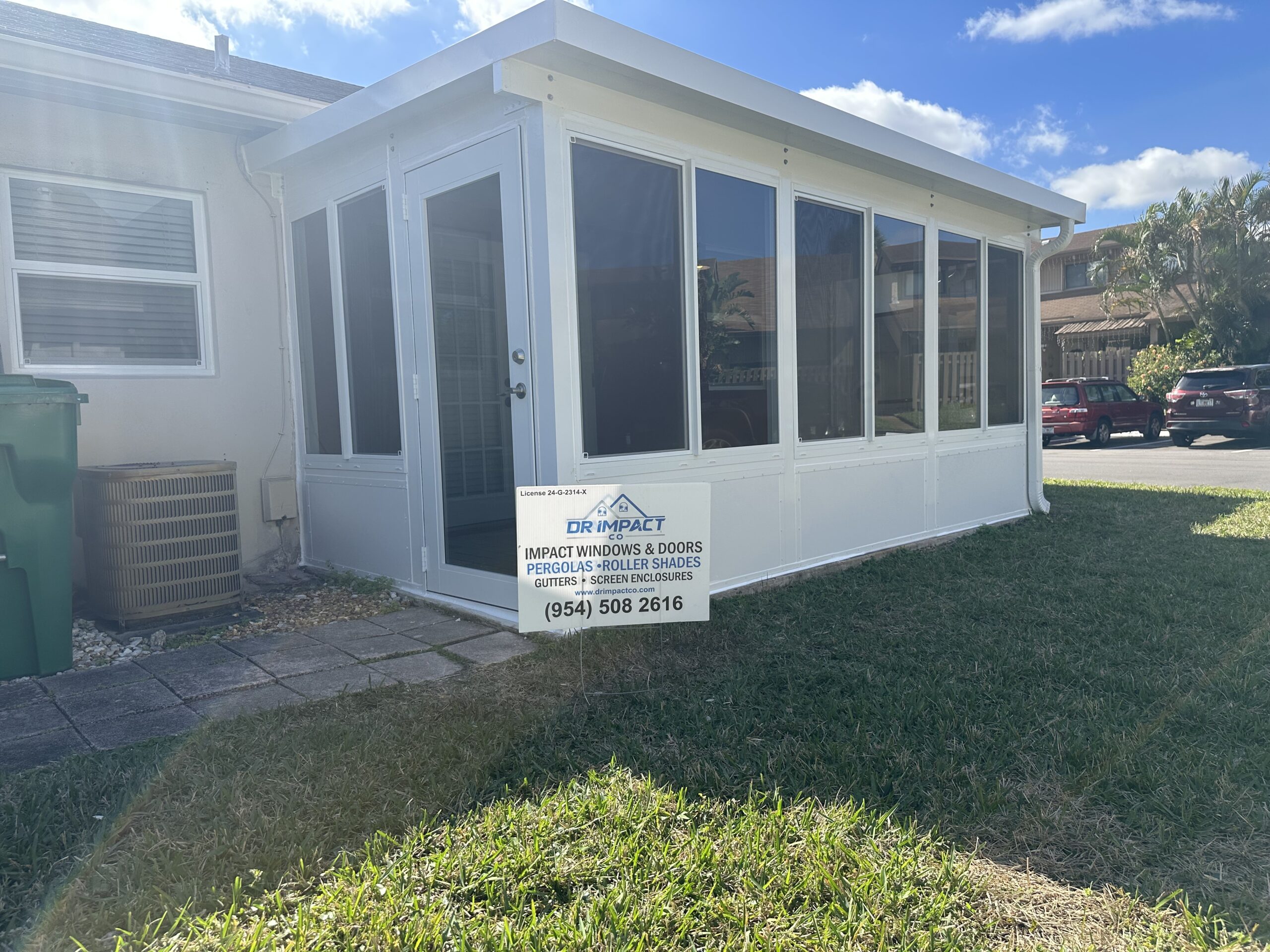How Sunrooms can benefit your Florida Home!

Turning your backyard patio into a sunroom or screened room, or a covered patio is a fantastic way to expand your living space while maximizing the enjoyment of your outdoor environment. A sunroom allows you to enjoy the beauty of your outdoor space no matter the weather. In Florida, bugs and mosquitoes can make outdoor living a challenge, especially in the evening. A sunroom offers a bug-free space where you can enjoy your patio without the nuisance of pests. You get all the benefits of outdoor living (fresh air, beautiful views, nature) but with the comfort and shelter of an indoor space. You can sip your morning coffee while watching the rain, enjoy a sunny afternoon without worrying about the sun's intensity, or dine alfresco-style without the fear of bugs. With a sunroom, you can create a dedicated space for family gatherings, meals, or quiet relaxation. Its ability to act as an extension of your living room or dining area makes it ideal for entertaining guests while still offering a cozy, private feel. by turning your backyard patio into an enclosed sunroom, you’re creating a more versatile, attractive, and comfortable home, one that feels larger, brighter, and more connected to nature—making it a truly valuable addition to your lifestyle and property.
Understanding Florida Building Code with Sunrooms and how they are classified
R301.2.1.1.1 Sunrooms.
Sunrooms shall comply with AAMA/NPEA/NSA 2100. For the purpose of applying the criteria of AAMA/NPEA/NSA 2100 based on the intended use, sunrooms shall be identified as one of the following categories by the permit applicant, design professional or the property owner or owner’s agent in the construction documents. Component and cladding pressures shall be used for the design of elements that do not qualify as main windforce-resisting systems. Main windforce-resisting system pressures shall be used for the design of elements assigned to provide support and stability for the overall sunroom.
Category I: A thermally isolated sunroom with walls that are open or enclosed with insect screening or 0.5 mm (20 mil) maximum thickness plastic film. The space is nonhabitable and unconditioned.
Category II: A thermally isolated sunroom with enclosed walls. The openings are enclosed with translucent or transparent plastic or glass. The space is nonhabitable and unconditioned.
Category III: A thermally isolated sunroom with enclosed walls. The openings are enclosed with translucent or transparent plastic or glass. The sunroom fenestration complies with additional requirements for air infiltration resistance and water penetration resistance. The space is nonhabitable and unconditioned.
Category IV: A thermally isolated sunroom with enclosed walls. The sunroom is designed to be heated or cooled by a separate temperature control or system and is thermally isolated from the primary structure. The sunroom fenestration complies with additional requirements for water penetration resistance, air infiltration resistance and thermal performance. The space is nonhabitable and conditioned.
Category V: A sunroom with enclosed walls. The sunroom is designed to be heated or cooled and is open to the main structure. The sunroom fenestration complies with additional requirements for water penetration resistance, air infiltration resistance and thermal performance. The space is habitable and conditioned.
1. Three-Season Sunrooms
- Purpose: These sunrooms are designed to be used for about three seasons of the year (spring, summer, and fall).
- Features: They typically have insulated glass and may not be heated or cooled to the same degree as the rest of the house, so they may not be suitable for cold winters.
- Construction: Often built with screens, large windows, and a roof that allows for lots of sunlight. They can be either attached or standalone structures.
2. Four-Season Sunrooms
- Purpose: Designed to be used year-round, regardless of the weather.
- Features: These rooms are fully insulated, heated, and cooled to match the home's climate control system. They're often equipped with more durable materials, such as insulated glass, to prevent heat loss.
- Construction: They tend to have heavier framing, stronger insulation, and may be integrated into the home’s existing HVAC system.
3. Conservatories
- Purpose: Typically used to showcase plants, a conservatory is a more traditional, formal design.
- Features: Often features lots of glass walls and a glass roof, providing ample sunlight for plants. It’s a highly aesthetic and often elegant space.
- Construction: Conservatories often have ornate architectural details, including vaulted ceilings and sometimes even wrought iron or wood framing.
4. Screened-In Porches
- Purpose: A variation of a sunroom, the focus here is on outdoor living without the presence of bugs or pests.
- Features: These are mostly open to the outdoors but are enclosed with screens, offering protection from insects while still allowing airflow and sunlight.
- Construction: Typically have open-air framing and are not fully enclosed with glass, though some might include partial glass or solid walls in certain areas.
5. Patio Rooms
- Purpose: These are often an extension of an existing outdoor patio or deck, but with more protection from the elements.
- Features: They can have large glass walls, sliding doors, or even retractable glass roofs to let in natural light while providing shelter.
- Construction: Generally simpler, sometimes more open-air than other sunrooms, and focused on casual outdoor living with the option for some indoor-like features.
6. Solariums
- Purpose: Solariums are often designed to maximize sunlight and provide a warm, inviting atmosphere.
- Features: Often feature floor-to-ceiling glass walls and roofs. The focus is typically on sun exposure, with these rooms providing a space for relaxation or plant growth.
- Construction: Similar to conservatories, but generally more modern and sleek in design, sometimes with a completely glass ceiling.
7. Florida Rooms
- Purpose: Originating in Florida, this type of sunroom is meant to allow for outdoor living while being protected from heat and rain.
- Features: It typically includes lots of windows, a fan for ventilation, and easy access to outdoor spaces like patios or decks.
- Construction: This style can vary widely but often combines elements of a screened-in porch and a fully enclosed sunroom.
8. Glass Rooms
- Purpose: These are often a luxurious, fully-glassed space, designed to be an upscale extension of your home.
- Features: These rooms are designed almost entirely out of glass to create the feeling of being outside, often featuring panoramic views.
- Construction: The structure uses large glass panels and may or may not have a solid roof. They are typically designed with energy-efficient, thermal-insulated glass.
Each of these sunroom categories can be customized based on your preferences and the climate of your area. Is there a particular type you're leaning toward, or maybe you want to dive deeper into one of these styles?


Write a Comment